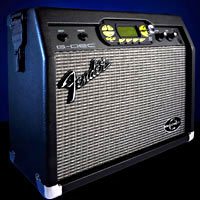Stratasys 3D Printing Helps Fender Cut Time to Market With Prototypes
Fender Rocks Amp Design, Slashes Time to Market By More than 50% with Stratasys 3D Printed Prototypes
Over the last 69 years, Fender Musical Instruments Corporation has established its position as the premier brand of guitars, amplifiers, PA sound equipment and foot pedals used by today’s leading performers and music enthusiasts. The American manufacturer has improved its time to market by 30-40% thanks to its in-house design center, powered by the Objet Eden350V 3D Printer from Stratasys.
Superior Products, Lower Costs
Exceptional products are the key to Fender’s unrivaled reputation. Shawn Greene, senior model maker, relies on Stratasys’ PolyJet 3D printing technology to develop detailed prototypes faster and more cost-effectively than ever before. Working with the Objet Eden 350V 3D Printer, instead of costly tooling processes and equipment, Greene’s team can achieve more creative and accurate concept designs with exceptional details.
A recent example is the Fender Passport sound equipment, a re-released, all-in-one transportable PA system. Fender’s R&D team 3D printed the different housing pieces, gluing them together and painting the parts with metallic colors during post-processing.
“We were actually able to put electronics and speakers in these and do sound tests for speakers, volume testing, and some heat testing—long before we spent one dime on tooling,” explained Greene.
Streamlining Design Process to Reduce Production Cycles
As the demand for faster innovation and improved supply chain efficiencies pose new challenges for manufacturers, 3D printing offers a powerful solution with its iterative design process. Fender is experiencing an accelerated time-to-market while reducing new product development risks with additive manufacturing methods. The latest amplifier, the G-DEC® (Guitar Digital Entertainment Center), went through various design iterations and market research studies before its final unveiling only six months after initial concept. According to Greene, traditional prototyping methods alone would have taken six to 12 months.
As Greene pointed out, “If I have an idea for something new and edgy, I can design it and have a prototype in just a few hours. If it doesn’t work out, I’ve only lost an afternoon instead of a week.”

Using PolyJet digital materials, prototypes of the Fender Passport system were 3D printed and put through numerous functional tests.
Encouraging Collaboration with 3D Printing

Fender used 3D printing to produce small parts like knobs on the G-DEC® amplifier, which accelerated the time to market by up to 12 months.
In addition to lower costs and shorter production cycles, 3D printing has improved collaboration between Fender’s R&D and marketing departments. “It’s so nice to be able to not just go to marketing and show them pictures or drawings,” said Greene. “We can show them an actual product, put it in their hands, set it in front of them and let them touch it. You can show something on paper all day long, but when you give them something real they can touch, people really get excited.”
3D printing has become an integral part of Fender’s everyday operations, with around-the-clock projects ranging from small amp knobs to full guitar body designs. “3D printing has pretty much affected everything we do,” added Greene. “I think it’s such a valuable tool for any designer, anyone who is making products. It gets your idea into hands so much faster, and it’s just a great technology to see your ideas come to fruition.”

 Blog
Blog